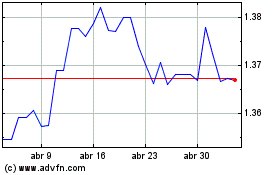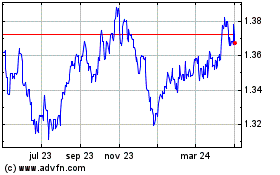U.S. Dollar Lower On Global Growth Concerns
14 Noviembre 2019 - 1:40AM
RTTF2
The U.S. dollar declined against its most major counterparts in
the European session on Thursday, as U.S.-China trade worries and
weak data from China and Japan stoked worries that a global
slowdown is deepening.
Chinese industrial output and retail sales figures for October
came in below estimates, while Japan's economy grew at the slowest
pace in a year in the third quarter.
Trade worries intensified after the Wall Street Journal reported
that trade talks have hit a snag over Chinese purchases of U.S.
agricultural products.
The report said that China is reluctant to commit to a specific
amount of agricultural products as part of the phase one trade
deal.
The news raised doubts about finalizing interim deal between
Beijing and Washington.
The currency showed mixed trading against its major counterparts
in the Asian session. While it was steady against the euro and the
franc, it fell against the yen. Versus the pound, it rose.
The greenback declined to a 10-day low of 0.9870 against the
franc, from a high of 0.9908 seen at 8:45 pm ET. The next possible
support for the greenback is seen around the 0.96 level.
The greenback fell to a 9-day low of 108.57 against the yen,
after reaching as high as 108.86 at 8:45 pm ET. If the greenback
slides further, it may find support around the 106.00 level.
Data from the Ministry of Economy, Trade and Industry showed
that Japan's tertiary industry activity rose in September.
The tertiary industry activity index rose 1.8 percent
month-on-month in September. Economists had forecast 1.1 percent
rise.
The greenback depreciated to a 2-day low of 1.2867 against the
pound, from yesterday's closing value of 1.2849. The greenback is
seen finding support around the 1.30 level.
Data from the Office for National Statistics showed that UK
retail sales decreased in October as a now-delayed Brexit deadline
approached, defying expectations for an increase, and suggest a
soft start for household spending in the fourth quarter.
Including automotive fuel, retail sales decreased 0.1 percent
monthly in October after a 0.2 percent decline in the previous
month.
In contrast, the greenback climbed to a 5-week high of 1.0989
against the euro, reversing from a low of 1.1016 hit at 3:15 am ET.
The currency is likely to locate resistance around the 1.06
level.
Data from Eurostat showed that Eurozone economy grew in the
third quarter as initially estimated.
Gross domestic product grew 0.2 percent from the second quarter,
when the economy expanded at the same rate.
The greenback rose to 1.3268 against the loonie and 0.6386
against the kiwi, from its early low of 1.3248 and a 9-day low of
0.6419, respectively. If the greenback rises again, it may test
resistance around 1.35 against the loonie and 0.62 against the
kiwi.
Extending early rally, the greenback appreciated to a 4-week
high of 0.6782 against the aussie. Next immediate resistance for
the greenback is seen around the 0.645 level.
Looking ahead, Canada new housing price index for September,
U.S. producer prices for October and weekly jobless claims for the
week ended November 9 will be featured in the New York session.
At 10:00 am ET, Federal Reserve Chair Jerome Powell will testify
on the economy before the House Budget Committee in Washington
DC.
US Dollar vs CAD (FX:USDCAD)
Gráfica de Divisa
De Mar 2024 a Abr 2024

US Dollar vs CAD (FX:USDCAD)
Gráfica de Divisa
De Abr 2023 a Abr 2024
